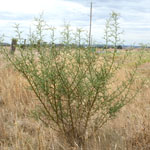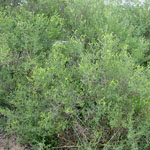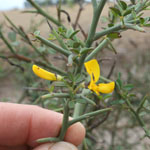Spiny broom
Common name:
- Spiny broom
Scientific name:
- Calicotome spinosa (L.) Link
Plant status
Catchment management authority boundaries
Regionally prohibited in the North East, Port Phillip and Western Port catchments.
Regionally controlled in the Wimmera and Corangamite catchments.
Restricted in the Mallee, Goulburn Broken, Glenelg Hopkins, West Gippsland, North Central, East Gippsland catchments.
Plant biology
Appearance
Shrub (or bush)
Description
Spiny broom is a perennial shrub.
Stems
Stems of spiny broom are multi-branched from the base and armed with sharp, rigid spines to 75mm long.
Young stems remain green for the first 2 to 3 years before turning brown.
Leaves
Spiny broom leaves are dark green or grey-green, hairy underneath and may occur in clusters.
Leaves are alternately arranged and are divided into three oblong to oval-shaped leaflets 5 to 10mm long, with the middle leaf being the largest .
The plant is deciduous but may also lose leaves under severe stress.
Flowers
Spiny broom flowers are bright yellow, 12 to 15mm long and clustered towards the end of branches. Spiny broom flowers in spring and summer usually when it is 2 or more years old.

Fruit
The fruit of spiny broom is grey-black or dark reddish-brown in colour.
Fruit are smooth, flattened pods about 40mm long with two pronounced ridges along one edge ending in a short spine. Pods contain between 3 to 15 seeds.
Growth and lifecycle
Method of reproduction and dispersal
Spiny broom is dispersed locally when its seeds are ejected from the pods during hot sunny weather. It is dispersed over further distances when it contaminates equipment, machinery, produce, animals and mud.
Seedbank propagule persistence
Little is known about the seedbank and propagule persistence of spiny broom, but closely related species like English Broom can produce over 12,000 seeds annually, with seeds able to last up to 30 years in the soil.
Preferred habitat
Spiny broom prefers warm-temperate regions growing on slightly acidic, dry, rocky soils in areas with moderate rainfall.
Growth calendar
The icons on the following table represent the times of year for flowering, seeding, germination, the dormancy period of Spiny broom and also the optimum time for treatment.
| Jan | Feb | Mar | Apr | May | Jun | Jul | Aug | Sep | Oct | Nov | Dec | |
|---|---|---|---|---|---|---|---|---|---|---|---|---|
| Flowering | ||||||||||||
| Seeding | ||||||||||||
| Dormancy | ||||||||||||
| Treatment |
Impact
Impact on ecosystems and waterways
Spiny broom can out-compete native plants and has an impact on native ecosystems, waterways, and agricultural land.
Agricultural and economic impacts
Dense infestations of spiny broom reduce grazing potential.
Management
Prescribed measures for the control of noxious weeds:
- application of a registered herbicide
- cultivation
- physical removal.
Read about prescribed measures for the control of noxious weeds.
Other management techniques
Changes in land use practices and spread prevention may also support spiny broom management after implementing the prescribed measures.